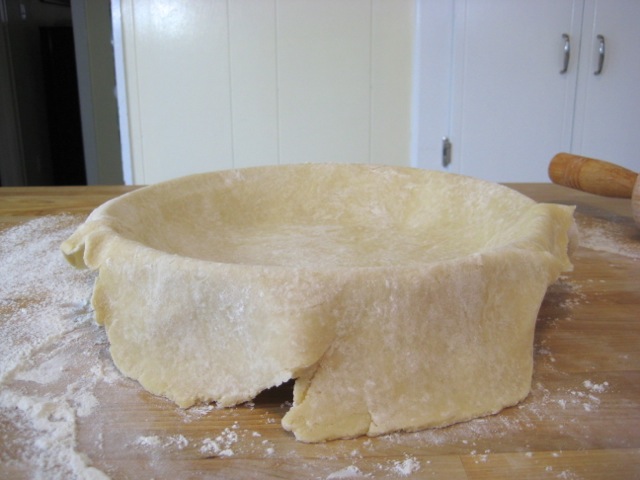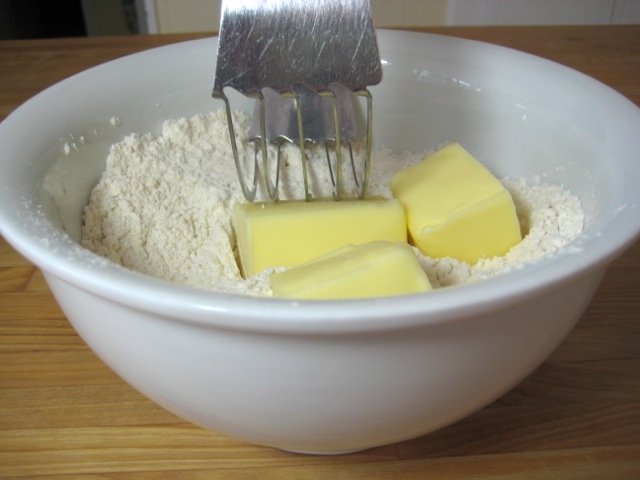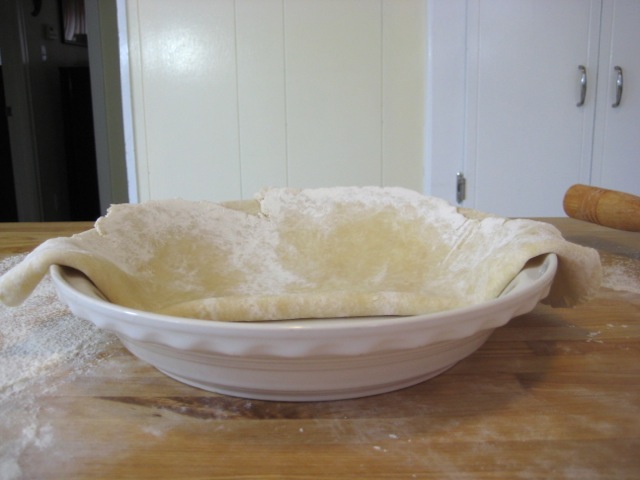I would like to encourage you to try it again using the tips below to guide you through the process.
I believe that making the dough for a pie crust is a very simple task, as long as you follow the recipe carefully.
Think of pie crust this way, it is just flour, salt, a fat such as shortening or butter, and cold water. A very simple list of ingredients.
So, how can you succeed at making a pie crust? Let me give you some basic information and techniques.
The Fat That Binds the Dough Together:
When making a pie crust you need some sort of fat to hold the flour and salt together.I like to make butter crusts because the flavor is so complimentary to any pie filling.
If you use all butter, make sure it is cold. Also, if you use salted butter then do not add salt to the flour mixture.
Lard is an excellent choice for pie crust, it is available in most grocery stores. It will yield the flakiest crust of any fats you can use.
Chill The Dough:
Once you have cut the butter or shortening into your flour mixture, place the crust in the freezer or refrigerator for 5 minutes.It is much easier to work with pie crust that is cold.
Cold Water:
Make sure the water you use is ice cold. If the recipe calls for 2 to 3 tablespoons of water you should err on the side of the full amount. For a single-crust pie I usually use 2½ tablespoons of cold water. For a double-crust pie I usually use 4½ tablespoons cold water.Pulling the Dough Together:
How will you know if you have enough water in the work bowl?Once you have stirred the crust mixture with a fork, you will need to use your hands to bring the crust together into a round ball. Work fast and if your hands are on the warm side, try sticking the dough in the refrigerator for five minutes once you have formed your dough ball.
If you can't pull all of the flour into the dough ball then you probably need a little bit more cold water. ½ tablespoon should be enough, if not add in small increments until you have the right consistency.
The dough ball should be soft and pliable, but not sticky and wet.
If it is too sticky, add a small amount of flour and work it in with your hands. 1 teaspoon increments is a good way to do this.
An Alternate Way to Mix Pie Crust Dough:
Using a food processor is an easy way to make pie crust that does not involve mixing by hand. I do not mix my crust this way, but you certainly can.- Simply place the flour, salt and butter into the food processor.
- Using the metal or plastic blade, pulse gently several times to incorporate the butter into the flour
- Pour the cold water into the work bowl
- Pulse gently until the dough comes together in a ball.
Rolling Out The Crust:
The best way to succeed when rolling out a pie crust is to make sure to dust not only your work surface with plenty of flour, but also your dough.- Dust the work surface with flour
- Place the ball of dough on the work surface
- Press the palm of your hand into the dough ball and flatten slightly
- Dust the dough with flour
- Pick up the dough and dust the work surface again
- Turn the dough over and set back down on work surface
- Dust the top of the dough
- Begin rolling the dough out with a rolling pin
- Move the dough around on the floured surface to prevent sticking
- Roll at different angles so that the dough will spread out into a circle
- Continue rolling the dough out until it is quite thin, about ⅛-inch.
- Dough is rolled out enough when it is 3-inches bigger in diameter than the pie pan
Placing the Crust in a Pie Pan:
Fold the rolled dough in halfPick it up gently and place over the pie pan so that the edge is 1 to 2-inches beyond the rim of one side of the pan and the fold is in the center of the pie pan.
Fold the dough over the entire pan.
Gently ease the crust into the sides and bottom of the pie pan so that it covers the entire surface.
Baking:
If you are pre-baking a crust you will need to prick the entire surface of the pie crust so that it doesn't bubble and shrink during baking.If you are filling the pie pan with a favorite pie filling do so.
Cut around the perimeter of the crust so that it is just a few centimeters out from the edge of the pie pan.
Bake according to directions.












